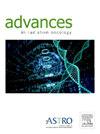Fuzzy Analytical Hierarchy Process-based Risk Priority Number Approach in Failure Modes and Effects Analysis for Magnetic Resonance Imaging-guided High-dose-rate Brachytherapy for Gynecologic Cancer
IF 2.2
Q3 ONCOLOGY
引用次数: 0
Abstract
Purpose
Failure modes and effects analysis (FMEA) is commonly used to identify, prioritize, and mitigate potential failure modes (FMs) by assigning a risk priority number (RPN). However, traditional RPN-based FMEA has limitations, particularly when handling the degree of interdependency within processes. To address this, we propose a fuzzy analytical hierarchy process (AHP)-based RPN method, designed to prioritize FMs by accurately weighing risk factors in magnetic resonance imaging (MRI)-guided high-dose-rate brachytherapy (BT) for gynecologic (GYN) cancer.
Methods and Materials
A process map covering all steps was developed for MRI-based GYN BT, and potential FMs were identified. Evaluators were given 2 questionnaires, one for conventional FMEA and another for AHP evaluation. For the AHP method, substeps were grouped by job specialty, with identical weights applied to FMs within each specialty group. Fuzzy linguistic terms helped evaluators handle uncertainties, and final fuzzy AHP-based RPN values were calculated by applying weighted risk factor scores.
Results
The process map included 6 primary steps, 33 substeps, and 82 FMs. In the fuzzy AHP RPN analysis, the top 5 FMs were identified as incorrect/suboptimal applicator insertion, incorrect applicator reconstruction, dose-volume histogram not meeting the physician's intent, incorrect/missing contours, and applicator/patient movement. By comparison, the conventional FMEA ranked the top 5 as incorrect/missing contours, incorrect/suboptimal applicator insertion, dose-volume histogram not meeting the physician's intent, applicator/patient movement, and incorrect applicator reconstruction. FMs with rank differences of 10 or more between methods were mostly related to applicator insertion and MRI.
Conclusions
This study demonstrates the feasibility and effectiveness of a fuzzy AHP-based RPN method for comprehensive FM prioritization, tailored to the clinical workflow of MRI-based GYN BT. Our findings provide a valuable reference for implementing fuzzy AHP-based risk assessment in MRI-guided BT.
基于模糊层次分析法的磁共振成像引导下高剂量率妇科肿瘤近距离放射治疗失效模式及效果分析
目的失效模式和影响分析(FMEA)通常用于通过分配风险优先级数(RPN)来识别、优先排序和减轻潜在失效模式(FMs)。然而,传统的基于rpn的FMEA具有局限性,特别是在处理过程内部相互依赖程度时。为了解决这个问题,我们提出了一种基于模糊层次分析法(AHP)的RPN方法,旨在通过准确权衡磁共振成像(MRI)引导的高剂量率近距离妇科(GYN)癌症治疗(BT)的危险因素来确定FMs的优先级。方法和材料为基于mri的GYN BT制定了涵盖所有步骤的流程图,并确定了潜在的FMs。问卷分为两份,一份是传统的FMEA,另一份是层次分析法。对于AHP方法,子步骤按工作专业分组,对每个专业组内的FMs应用相同的权重。模糊语言术语帮助评估者处理不确定性,并通过加权风险因素得分计算最终基于模糊层次分析法的RPN值。结果该流程图包括6个主要步骤,33个次要步骤,共82个FMs。在模糊AHP RPN分析中,前5个FMs被确定为不正确/次优涂抹器插入,不正确的涂抹器重建,剂量-体积直方图不符合医生的意图,不正确/缺失轮廓,以及涂抹器/患者运动。相比之下,传统的FMEA将前5名排在不正确/缺失的轮廓、不正确/次优的涂抹器插入、剂量-体积直方图不符合医生的意图、涂抹器/患者运动和不正确的涂抹器重建。两种方法之间的等级差异在10或10以上的FMs主要与涂抹器插入和MRI有关。结论本研究验证了基于模糊层次分析法的RPN方法的可行性和有效性,该方法适用于基于mri的GYN BT临床工作流程,为在mri引导的BT中实施基于模糊层次分析法的风险评估提供了有价值的参考。
本文章由计算机程序翻译,如有差异,请以英文原文为准。
求助全文
约1分钟内获得全文
求助全文
来源期刊

Advances in Radiation Oncology
Medicine-Radiology, Nuclear Medicine and Imaging
CiteScore
4.60
自引率
4.30%
发文量
208
审稿时长
98 days
期刊介绍:
The purpose of Advances is to provide information for clinicians who use radiation therapy by publishing: Clinical trial reports and reanalyses. Basic science original reports. Manuscripts examining health services research, comparative and cost effectiveness research, and systematic reviews. Case reports documenting unusual problems and solutions. High quality multi and single institutional series, as well as other novel retrospective hypothesis generating series. Timely critical reviews on important topics in radiation oncology, such as side effects. Articles reporting the natural history of disease and patterns of failure, particularly as they relate to treatment volume delineation. Articles on safety and quality in radiation therapy. Essays on clinical experience. Articles on practice transformation in radiation oncology, in particular: Aspects of health policy that may impact the future practice of radiation oncology. How information technology, such as data analytics and systems innovations, will change radiation oncology practice. Articles on imaging as they relate to radiation therapy treatment.
 求助内容:
求助内容: 应助结果提醒方式:
应助结果提醒方式:


